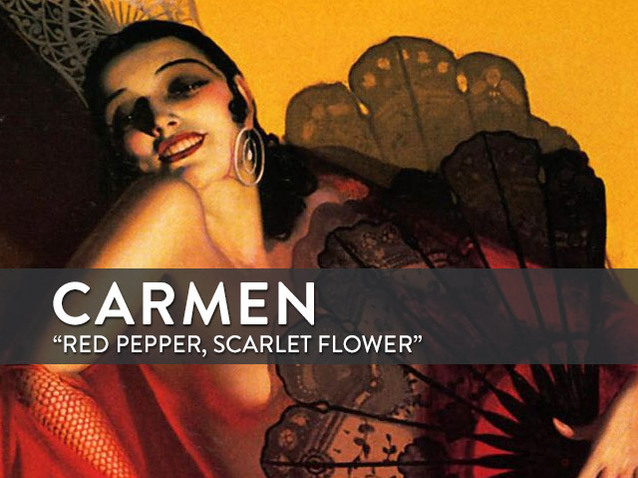 © DR
© DR
If Carmen is today the most played opera in the world, it wasn't as acclaimed when it was created (mostly because of the libretto considered as "scandalous"). Bizet's work is an ode to freedom which ends in tragedy and questions us about the meanings of passion and duty. And this year, the french festival Les Chorégies d'Oranges is giving a new production with Kate Aldrich singing the title role, besides Jonas Kaufmann and Inva Mula. The occasion to deepen the history and the context of Bizet's emblematic opera.
***
What is there left to say about Carmen, whose perfect success was praised by such demanding musicians as Tchaikovsky, Brahms, Wagner and Richard Strauss?The work is so well known that some think they can listen to it as a series of “hits” whose effectiveness is obvious.But how could the full richness of the title role – one of the most fascinating for audiences and for the many performers who have played it – be exhausted?Poet Théophile Gautier, in his Emaux et Camées (1852), summarises in a few verses all the character’s dangerous seductiveness:“And, amidst her pallor, burst open / A mouth with a winning laugh / Red pepper, scarlet flower / That takes its crimson from the blood of hearts”.The very first notes of the Prelude to Carmen scatter dazzling sensual colours that reveal the gypsy girl’s silhouette, free-spirited to the point of insolence.A femme fatale who bewitches Don José by tossing him a “cassia flower”, Carmen is more than just a Don Juan in skirts.A transgressive figure who appeared from out of nowhere, carried towards death by the impetuosity of her desires, she moves in the diabolic reddish glow of a devastating passion.“You are the devil”, Don José tells her.The audience will see the indomitable Carmen’s blood flow on the stage.By having his heroine die, Bizet casts aside boundaries between genres.He carries us along with the apparent lightness of a comic opera until it turns tragic, with the intensity and depth of his music bringing back to life the passionate violence of the Mérimée novel that inspired it.
The Success of “A Rebellious Bird”
It is often noted that Mozart died young, at the age of 35.But we forget that Georges Bizet (1838-1875) himself died at 36, after associating his name with a wildly famous work, the opera that still today is the most often played in the world:Carmen.Of all that Bizet wrote in his roughly twenty-year career, all that is left for the general public is this work taken from a short story by Prosper Mérimée. Before Carmen, whose success was initially highly controversial, Bizet went from semi-failures to unfinished projects.He destroyed a great deal and lost a lot of time, because he lacked self-confidence.Then how did he manage to unleash his talent to conceive such a masterpiece?This is undoubtedly one of the paradoxes surrounding this composer, who made so many music lovers want to go to Spain when they had never set foot there!
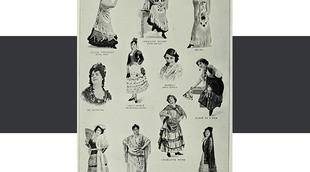
Are we to view the astonishing encounter Bizet had in 1864 as a first sign of destiny?At a music hall, his attention was drawn to a certain Céleste Mogador who was performing a song by Sebastián de Yradier (1809-1865), Ay Chiquita, drawn from his album of melodies, Flowers of Spain.A disturbing detail: a copy of this collection was found in the library of Carmen’s author, who might well be the sister of the surprising Céleste Mogador.She was a 41-year-old woman who had already lived several lives:ex-prostitute, ex-dancer, ex-horsewoman, ex-Countess de Chabrillan, author of operetta librettos and novels, she was also an actress and singer.Aspiring to a life of calm and respectability, she had just purchased an estate and chalet in the Vésinet.She willingly accepted the composer’s friendship but rejected his advances in no uncertain terms:this strong-willed woman intended to keep her freedom.Of the self-portrait she left in her Mémoires, the primary traits of the future Carmen can be glimpsed:“I loved with passion or I hated with rage…It is not in my nature to try anything half-heartedly…No woman inclined to say yesoften feels more pleasure than I do when I say no”.
In June 1872, just after the failure of Djamileh, Adolphe de Leuven, director of the Opéra-Comique, commissioned Bizet.Bizet proposed Carmen, but when he familiarised himself with the subject, the cautious director was startled:“Mérimée’s Carmen!Doesn’t she get killed by her lover?And that milieu of thieves, gypsies and cigar sellers!At the Opéra-Comique!The family theatre!The theatre used for marriage interviews!Try not to let her die!Death at the Opéra-Comique!This has never been seen before!”. Fortunately, Camille du Locle bought out Leuven’s shares and became the sole sponsor of the Opéra-Comique:he agreed to Carmen.Bizet set to work with a passion.The famous duo of Henri Meilhac and Ludovic Halévy wrote the libretto.The two accomplices worked diligently to make acceptable for middle-class audiences a subject very far from those ordinarily offered up to them by Offenbach, with whom they had co-authored more than one success.That is how they came to invent the sweet character of Micaëla, “blue skirt, her plaits falling over her shoulders”.The chaste, pure girl contrasts sharply with the wild and fiery Carmen who dreams of taking Don José after the smugglers, “là-bas, là-bas dans la montagne”.Micaëla is full of freshness and naïveté like marriageable young ladies who accompany their respectable parents to soirées at the Salle Favart.Meilhac and Halévy also created the toreador Escamillo, a picturesque, conventional character who represents all the rivals Don José had to agree to share Carmen with in Mérimée’s short story.The secondary characters also undergo a metamorphosis that makes them closer to the world of the opera-comique.
Bizet completed the 1,200 pages of his score at Bougival, in a house he rented to flee the Parisian upheaval in 1874.In October, rehearsals began in a tumultuous atmosphere.The orchestra musicians found the score too difficult, the choristers refused to budge while singing, claiming that the chorus of cigar girls was “unexecutable”, even after two months of intense work.After the originally scheduled singer withdrew because of the subject matter, a young mezzo with a “spicy and tender” voiceand “feline grace and fierce energy” is chosen:Célestine Galli-Marié.She believes in Carmen’s character.At the recommendation of Célestine Galli-Marié, Bizet replaced the first entrance aria he had written for his heroine with a “local colour” piece, the famous Habañera that serves as “La Carmencita”’s flamboyant standard.It is an adaptation of a song by Sebastiàn de Yradier entitled El Arreglito which the disturbing Céleste Mogador perhaps used to sing…In any case, the director of the Opéra-Comique did not share the composer’s enthusiasm or confidence, predicting a resounding failure and declaring to anyone who would listen that the music in Carmen seemed “Cochin-Chinese and completely incomprehensible”!
Carmen’s Birth and Bizet’s Death
The premiere was set for 3 March 1875. That same morning, the Legion of Honour was bestowed upon Bizet.One witness declared that if he was decorated in the morning it was because they knew they couldn‘t do it in the evening!The performance was a bit tense. Yet the work adopted the customary form of works presented at the Opéra-Comique.No transgression or scandal there.Carmen alternates sung numbers, spoken dialogue and dancing divertissements.The plot unfolds with impeccable dramatic effectiveness:Carmen seduces Don José, plunges him into despair, and then, when she abandons him for Escamillo, he kills her.The audience was more discomfited than openly hostile, but it was by no means won over.What Bizet termed “an operetta that ends badly,” the critics could not find words strong enough:“Once one has plunged into the social sewer, one is forced to descend even further; one always chooses one’s models lower down.”Carmen is compared to a “sidewalk Célimène”, and she is seen as an “ignoble villainess”.Another critic cited “females spewed out of Hell” surrounding a Carmen at the mercy of “uterine furies”!The rejection appeared unanimous against “the shame of such a subject, which in two centuries had never dishonoured a stage intended for delicate pleasures and divertissements in good company”.This indicates that the music was hardly even heard.Except for Bizet’s friends, who were the crème de la crème of the audience for that memorable premiere:Gounod, Delibes, Ambroise Thomas, Offenbach, Lecocq, Massenet, D’Indy and Daudet, Dumas Fils, Hortense Schneider, all of them were won over and realized they were witnessing the discovery of a masterpiece that would mark the history of the lyric theatre.Bizet’s name was bandied about like the flagbearer for the avant-garde musical.Poet Théodore de Banville did not hesitate to speak of a “coup d’état” by the one who “sought to show real men and real women dazzled and tortured by passion”.He also lauded:“The divine language (…) of the orchestra, become creator and poet” which expresses “the anguish, the madness, the celestial aspirations of the one who, covered in mire and azure, is here below a passer-by and exile”. In the Revue des Deux Mondes, it was reported with great admiration for the score:“The voices fall from who knows where; there are rocket rhythms, zigzag lightning bolts starting high and leaving their wake in the melodic plot.”
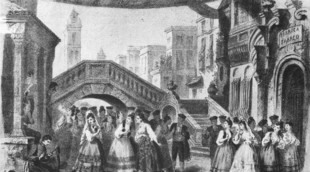
Deeply disappointed by the chilly public reception for Carmen, and disturbed by the misunderstanding that was destroying his marriage, Bizet was also struck by a “colossal angina”.In May he decided to leave for a rest in Bougival with his wife and child.Delaborde, a charming pianist who pursued his wife unrelentingly, joined them.On 29 May the two men were imprudent enough to bathe in the icy Seine.The following day Bizet was in bed, paralysed by acute rheumatism.A first heart-attack crisis caused everyone to fear the worst, but the physician appeared reassuring.Unfortunately, Bizet succumbed to a second heart attack on June 3.A curious series of coincidences then struck everyone’s imagination:Carmen was created on the third day of the third month of the year.Three months later, on 3 June, Bizet died – just as Mme Galli-Marié, singing the card trio for the thirty-third time of the year, sang “la carte impitoyable qui dit toujours: la Mort”.The gypsy’s fatalism had worked its way into reality.She who accepts death like love at the whim of fantasies of her fate was to be the musician’s last heroine.
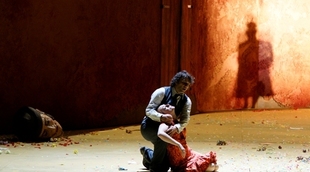
Bizet died without knowing the fabulous fate his Carmen would experience.The young people sing as they impatiently wait for her at the tobacco factory’s exit, “Carmen, sur tes pas, nous nous pressons tous”, including audiences and performers…Starting with the singers who dream of performing her.Régine Crespin, who sang the role for the first time in New York in 1975, painted a passionate portrait of the captivating gypsy:“Singing Carmen, I discovered this character who seemed to me, I have to say, a bit vulgar.I hadn’t seen the sensuous depth (but the flirtatiousness), the humour, or the bodily expressiveness (…).Now, Carmen is a highly complex character (…) torn, it seems to me, between two aspects (…): on one hand, this apparent superficiality, this laughing casualness, this swirling lightness, unconscious, and then on the other hand a profoundly dramatic complexion, and in fact wilfully ‘suicidal’” (Avant-Scène Opéra no. 26).In many passages, Carmen seems to summon death as if to prepare herself with a sort of unshakeable resoluteness.“Frappe-moi donc ou laisse-moi passer” are her last words before, in a last act of defiance, she throws the ring Don José had given her at him.
The Paris performances of Carmen ended after the composer’s death.Only after it toured the world and underwent many changes did Carmen return to Paris, on 21 April 1883 at the Salle Favart.The woman whose name means “charm” in Latin began by bewitching Vienna on 23 October 1875. The Viennese discovered the work in a German version with the recitatifs composed by Ernest Guiraud to replace the spoken dialogue; they would be used by international opera houses until 1964, when a critical edition by Fritz Oeser appeared restoring the dialogues.Guiraud's adaptation was the origin of a great deal of confusion in establishing the score, and Oeser’s attempt was itself harshly criticised.The first great production marking a return to the original was that of Leonard Bernstein at Metropolitan Opera in 1972!The recording by Sir Georg Solti in 1975, with Tatiana Troyanos in the title role, is generally considered to be the text most faithful to the composer’s intentions.
“Et j’étais une chose à toi”
Carmen opens in the picturesque atmosphere of an operetta with a first genre scene, on a plaza in Seville where “Chacun passe, / Chacun vient, chacun va”.The tragic dimension takes shape quickly with the entrance onto the stage of the heroine, and the total contrast she creates with the character of her “victim”, Don José.Carmen, the rebel fatalist, crosses paths with a soldier who until then had been dominated by his attachment to his mother and his homeland, Navarre.In the First Act duet, Don José is able to open his heart to Micaëla, launching into a tender and nostalgic evocation:“Parle-moi de ma mère”.This duet, full of sweetness and naïve freshness, is punctuated by a refrain, “Ma mère je la vois”, which was one of Wagner’s favourite passages; he was a great admirer of Carmen.In these softened inflexions that beautifully express Bizet’s melodic genius, we glimpse a certain fragility in the character, contrasting with the strength emanating from the demonic “Carmencita”, presented to the bewitching beat of:“l’amour est enfant de bohème”.Nietzche was enthusiastic about this “habañera”:“It is an exercise in seduction, irresistible, satanic, ironically provocative.That is how the Ancients imagined Eros.I know of nothing similar (in music)”.In this tragedy of misunderstandings, Fate and Death constantly cast their menacing shadow over the lovers.
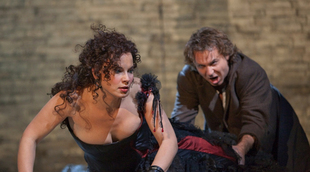
During the scene in which Don José runs into Carmen again at Lillas Pastia’s place, the two protagonists dialogue without understanding each other, and whilst Don José ends up deserting to follow the one who promises to be his mistress, it is despite himself and almost by chance.In prison, he thought constantly of Carmen but without really measuring what the gypsy “wandering life” represents.In a magnificent aria introduced by an English horn solo, “La fleur que tu m’avais jetée”, the character reveals his true dimension, expressing all the sincerity of his impossible love.The great tenor Roberto Alagna brilliantly clarifies Don José’s character when he underscores the musical success of the pianissimo on the final B flat sharp:“Et j’étais une chose à toi”.The pianissimo, followed by the surprising cadence of three chords on “Carmen, je t’aime”, expresses the helplessness of the unhappy soldier, torn between his sense of duty and his amorous desire.Don José admits he has become a “thing” turned over to Carmen’s whims.Both “man-object” and “martyr”, he seems destined to go through all the stages of a veritable Way of the Cross.Don José will be unable to match the almost animal fury that is Carmen’s until he throws himself upon her and kills her in a burst of savage fury.The deliverance of the “man-object” involves the murder of the inflexible and cruel lover during the terrible final duet before the arenas of Seville.Curiously, this announced “killing” occurs against a backdrop of general jubilation.This procedure is constantly used by Bizet throughout the work, in which we found many choruses associated with family scenes and picturesque crowds.All these choral interventions serve as counterpoint to the dramatic confrontations and spotlight the violence.
Carmen has become a mythical character, like Mozart’s Don Giovanni whose fierce will she shares to defy men and their beliefs until death.She intrigues and excites people who are not normally opera-goers.Everyone can form their own idea of her and find it in the various facets of her character, but it is first and foremost Bizet’s music that gives her that mysterious radiance.And that is why all the greatest singers have wanted to play her:Victoria de Los Angeles, Jane Rhodes, Teresa Berganza and Béatrice Uria-Monzon, to mention only a few.What would Carmen be without the melodic intervention, without the expressive power and the art of individualising the singing, without the orchestration’s dazzling colours full of delicacy?A picturesque character limited to the world of opéra-comique.
Catherine Duault
the 06 of July, 2015 | Print



Comments